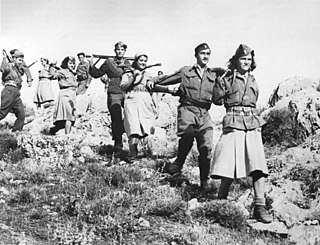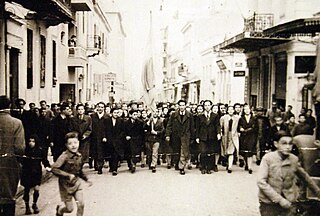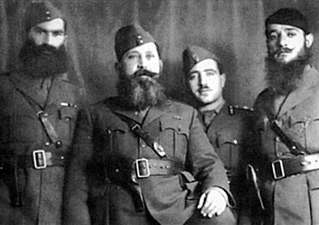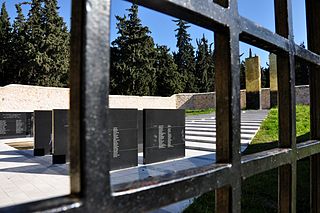Related Research Articles

The Greek People's Liberation Army was the military arm of the left-wing National Liberation Front (EAM) during the period of the Greek resistance until February 1945, when, following the Dekemvriana clashes and the Varkiza Agreement, it was disarmed and disbanded. ELAS was the largest and most significant of the military organizations of the Greek resistance.

The Greek resistance involved armed and unarmed groups from across the political spectrum that resisted the Axis occupation of Greece in the period 1941–1944, during World War II. The largest group was the Communist-dominated EAM-ELAS. The Greek Resistance is considered one of the strongest resistance movements in Nazi-occupied Europe, with partisans, men and women known as andartes and andartisses, controlling much of the countryside prior to the German withdrawal from Greece in late 1944.

The National Republican Greek League was a major anti-Nazi resistance group formed during the Axis occupation of Greece during World War II.

The Security Battalions were Greek collaborationist paramilitary groups, formed during the Axis occupation of Greece during World War II in order to support the German occupation troops.

The occupation of Greece by the Axis Powers began in April 1941 after Nazi Germany invaded the Kingdom of Greece in order to assist its ally, Italy, in their ongoing war that was initiated in October 1940, having encountered major strategical difficulties. Following the conquest of Crete, the entirety of Greece was occupied starting in June 1941. The occupation of the mainland lasted until Germany and its ally Bulgaria withdrew under Allied pressure in early October 1944, with Crete and some other Aegean islands being surrendered to the Allies by German garrisons in May and June 1945, after the end of World War II in Europe.

The Greek Civil War took place from 1946 to 1949. The conflict, which erupted shortly after the end of World War II, consisted of a Communist-led uprising against the established government of the Kingdom of Greece. The rebels declared a people's republic, the Provisional Democratic Government of Greece, which was governed by the Communist Party of Greece (KKE) and its military branch, the Democratic Army of Greece (DSE). The rebels were supported by Albania and Yugoslavia. With the support of the United Kingdom and the United States, the Greek government forces ultimately prevailed.
The Holocaust of Kedros, also known as the Holocaust of Amari, was the mass murder of the civilian residents of nine villages located in the Amari Valley on the Greek island of Crete during its occupation by the Axis powers in World War II. The massacre was a reprisal operation mounted by Nazi German forces.

On 1 May 1944, 200 Greek communists were executed at the firing range of the Athens suburb of Kaisariani by the Nazi occupation authorities as reprisal for the killing of a German general by Greek Resistance forces.
The Battle of Fardykambos, also known as the Battle of Bougazi, was fought between the National Liberation Front (EAM-ELAS) of the Greek Resistance against the Italian troops during the Axis Occupation of Greece. The battle was notable for the large-scale and spontaneous participation of the local populace, and of officers from other groups and organizations, including right-wing rivals to ELAS.
The Battle of Menina was conducted by the Greek resistance group EDES against the German garrison of the village Menina, Thesprotia, during the German occupation of Greece. They were successful and captured a large quantity of supplies.
The Battle of Meligalas took place at Meligalas in Messenia in southwestern Greece, on 13–15 September 1944, between the Greek Resistance forces of the Greek People's Liberation Army (ELAS), military wing of the Communist-dominated National Liberation Front (EAM), and the collaborationist Security Battalions.
Major General (Generalmajor) Franz Krech was the German commander of the 41st Fortress Division of the Wehrmacht during the World War II Axis occupation of Greece. He was ambushed and killed by a platoon of the Greek People's Liberation Army (ELAS) in Molaoi, Laconia. It led to harsh reprisals by the occupying forces and contributed to the declaration of the Peloponnese as an "operational zone", i.e. a war zone.

The Executions of Kokkinia took place on the August 17, 1944, and was the largest Nazi roundup and one of the largest-scale war crimes perpetrated during the German occupation of Greece. The operation was carried out by members of the Luftwaffe and collaborationist Security Battalions, and involved the execution of hundreds of civilians, thousands of hostages being sent to concentration camps, and the burning down of entire house blocks, as well as significant atrocities. The massacre was partly in retaliation for the Germans' defeat in Battle of Kokkinia five months before, on 4-8 March 1944. The leaders and members of the Security Battalions involved in the killings were never convicted by the Greek state.
Red Terror is a term used by some historians to describe incidents of violence against civilians that were considered "traitors" by EAM, because these civilians allegedly collaborated with groups that wanted Greece to be under the political, economic and military influence of other foreign forces; either of Axis powers, from 1943 to 1944 or under British influence, from 1943 to 1949 and during the Greek Civil War. In the countryside, operations were conducted by the ELAS; in cities, by the Organization for the Protection of the People's Struggle (OPLA).

The Aigaleo Massacre was a mass execution carried out by the Nazi occupation forces on September 29, 1944 in Agios Georgios neighborhood of Aigaleo, Attica, Greece. The official number of victims is 65, however some estimations raise the number of victims to about 100 or 150. In the site of the executions the local community has built a memorial for the victims.
The Battle of Kalamata took place on 9 September 1944, between ELAS against the collaborationist Security Battalions and the gendarmerie. It resulted in ELAS' victory and the liberation of Kalamata. After the battle, members of the Nazi collaborators were killed by the crowd.
The Battle of Amfilochia began on the evening of July 12, 1944 and lasted until the afternoon of the following day, involving guerrilla forces of the Greek People's Liberation Army (ELAS) against occupation forces of the 104th Jäger Division and local Gendarmerie forces. It resulted in a victory for ELAS and was one of the largest tactical operations of ELAS throughout the Axis occupation of Greece, both in terms of forces involved and result.
The Battle of Chora - Agorelitsa was fought on July 19, 1944 between Greek Peoples' Liberation Army (ELAS) against the Nazi occupation forces.
The Battle of Karoutes, was fought on August 5, 1944, between the Greek People's Liberation Army (ELAS) and the 18th SS Mountain Division.
References
- ↑ Archived 2019-05-29 at the Wayback Machine Η Μάχη της Κοκκινιάς
- ↑ Archived 2019-05-29 at the Wayback Machine Η Μάχη της Κοκκινιάς
- ↑ Archived 2013-09-10 at the Wayback Machine Η Μάχη της Κοκκινιάς
- ↑ "Η μέχρις εσχάτων πολυθρύλητη μάχη της Κοκκινιάς". Newsbeast (in Greek). 2016-03-12. Retrieved 2022-09-19.
- ↑ Σήμερα .gr, Σαν. "Το Μπλόκο της Κοκκινιάς". Σαν Σήμερα .gr (in Greek). Retrieved 2022-09-19.